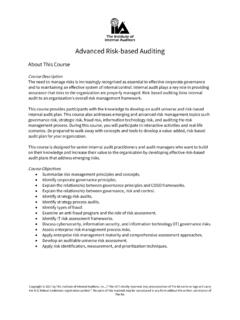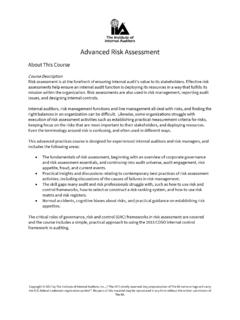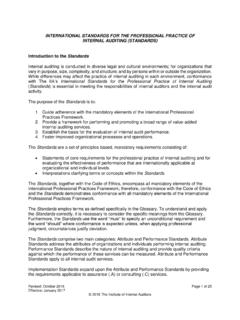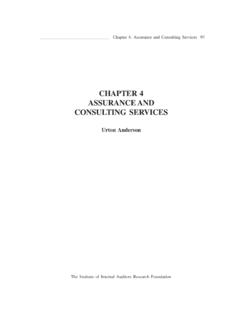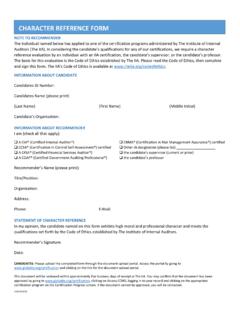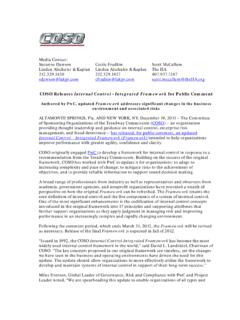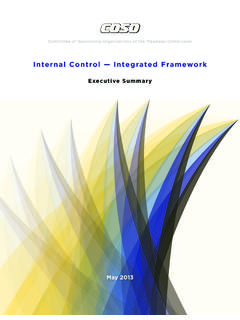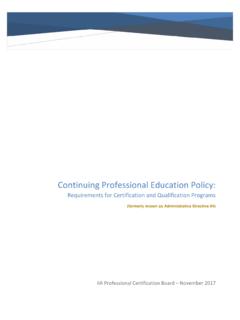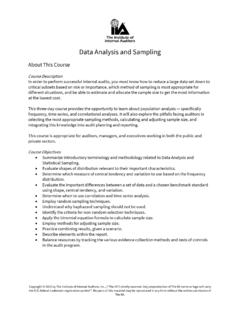Transcription of for Audit Committees - The Institute of Internal Auditors
1 For Audit Committees Performed by professionals with an in-depth understanding of the business culture, systems, and processes, the Internal Audit activity provides assurance that Internal controls in place are sufficient to mitigate the risks, that the governance processes are adequate, and that organizational goals and objectives are met. The Audit committee and the Internal Auditors are interdependent and should be mutually accessible, with the Internal Auditors providing objective opinions, information, support, and education to the Audit committee; and the Audit committee providing validation and oversight to the Internal Auditors . The Audit Committee: Purpose, Process, and Professionalism, The Institute of Internal AuditorsThe IIA s Three Lines Model: An Update of the Three Lines of Defense clarifies the essential roles and duties in three areas of an organization: the first and second lines encompass operational management, risk management, and compliance functions; and in the third line, Internal Audit (IA) provides independent and objective assurance and advice on the adequacy and effectiveness of governance and risk management.
2 Company boards of directors and their Audit Committees depend on IA to provide accurate, timely, and objective information and observations about the broad spectrum of areas they examine within an organization. As the Audit committee (AC) discharges its governance role, the relationship with IA is critical. The AC can have broad remit, with responsibility for oversight of financial reporting, risk management, Internal control, compliance, ethics, management, and Internal or external Auditors . (The AC s role in its relationship with IA is discussed in detail in The Audit Committee: Purpose, Process, and Professionalism.) Given the importance of IA s role, a regular evaluation of the IA activity can give boards and Audit Committees confidence that the Internal Auditors are performing their job effectively based on the International Standards for the Professional Practice of Internal Auditing, best practices, and the board and Audit committee s specific expectations.
3 This assessment tool offers suggestions for issues to be addressed in an evaluation based on established best practices. It is not intended as mandatory guidance, but rather as a resource that boards and Audit Committees can use in whole or in part to explore: +The quality of the services the company is receiving from IA and the sufficiency of resources at its disposal. +The level of communication and interaction with the IA team. +The independence, objectivity, and skepticism of the IA team. Each section includes a series of questions in fundamental areas that boards, Audit Committees , and others can ask to better understand the IA activity and to develop their own plans for enhancing the input and value of this important area. Section I: Introduction2 Internal Audit ASSESSMENT TOOL FOR Audit COMMITTEESSome jurisdictions establish standards and regulations that address the need for assessments in IA and the importance of a quality improvement process (see Appendix).
4 While that guidance sets forth essential requirements for IA assessment and quality, it is then up to the AC to probe additional critical issues. This can help the AC to maintain an ongoing understanding of the IA activity plan, how well it is achieving its goals, how effectively its work fulfills organizational needs, and whether the organization is making the best use of the resources and value -added services that the IA activity has to offer. As is indicated by many of the questions in this assessment tool, beyond any assessment, there should also be open, frequent, and bidirectional communication as needed between the chief Audit executive (CAE) and the AC chair. There are many other benefits to monitoring the performance of the IA activity, including: +Enhancing understanding of IA effectiveness and the efficiency of its work. +Gaining reassurance that IA efforts support strategic objectives of the enterprise, the board, and the AC.
5 +Receiving valuable updates on key considerations, including the effectiveness of controls and risk management. +Identifying insights into opportunities to improve the efficiency and/or effectiveness of the IA activity. +Understanding ways to enhance the working relationship with external Auditors , and other third parties, as applicable. +Opening up greater chances for candid dialogue, including honest feedback from IA and constructive feedback from the board or AC, which can help improve the quality of engagements and strengthen the relationship between the AC and IA. Questions to Ask About AssessmentAs members of the board and AC review the questions in this assessment tool, they should consider these big-picture questions that relate to their own oversight of the IA activity: +Is there an annual IA assessment process that is effective but not overly burdensome? +Is there an assessment of how well IA is gathering and using information and helping the business to drive decisions?
6 +Is the assessment effective in helping leadership and IA activity leaders understand the role of IA in the organization and the need or opportunities for changes in its role? Comprehensive, periodic assessments can prevent a sense of complacency that assumes all is well and fails to uncover challenges or opportunities for the IA activity. The next sections offer specific questions that boards and ACs can tailor to their own assessment needs. Section II: The Assessment Process3 Internal Audit ASSESSMENT TOOL FOR Audit Committees An organization is best served by a fully resourced and professionally competent Internal Audit staff that provides value -added services critical to efficient and effective organizational management. Internal Auditing: Adding value Across the Board, The Institute of Internal AuditorsAn evaluation of the quality of the services and resources provided by IA is a fundamental part of any assessment.
7 The overall goal in this section of the assessment is to consider: +The AC s ability to evaluate the IA activity. +The degree by which the IA activity is conforming to standards and its own improvement program. +Whether IA is performing in line with responsibilities contained in the activity s charter, and meeting AC expectations. +The quality of the insights and foresights that IA provides on governance, risk management, and control matters. +IA s use of technology and technical expertise. +Whether IA s work has a positive impact on the organization. +The competency and performance of IA leadership and team as well as the effectiveness in carrying out their professional responsibilities. The IIA s Internal Audit Competency Framework can be a key resource in this consideration. +If IA uses benchmarking to evaluate whether it is making the best use of its resources or if improvements are necessary in the resources available or the way they are the questions below to address these and other key issues.
8 Keep in mind that the questions throughout the document generally point to best practices. While the steps discussed may not be required, boards and ACs may want to consider including them in their oversight of the IA activity. In some cases, the AC may need to pose these questions to management to receive the information it needs. For all questions in this document, space is also left for observations on each topic. However, documenting answers is not as important as considering if and how exploring the answers might help the AC in its oversight role and focusing on areas that merit further exploration. Section III: Quality of Services and Sufficiency of Resources Provided by the Internal Audit Activity 4 Internal Audit ASSESSMENT TOOL FOR Audit COMMITTEESSAMPLE QUESTIONSOBSERVATIONSP erformance and Expectations Has IA had a positive impact on the organization since the last assessment?
9 Were matters IA brought to the AC s attention relevant? Was there adequate support for its observations and conclusions? Does IA s definition of success correlate with that of the AC? Is IA designed to meet organizational needs and to add value that will help the business improve going forward? Is IA succeeding at monitoring the financial, operational, and compliance controls (including technology-driven areas)? Are IA resources sufficient to fulfill its charter and meet the expectations of the board and AC? Does the Audit team have an Audit strategy? Does the strategic vision include workforce planning for the Audit team that addresses the resources necessary to deliver effective service ( , adequate resource and talent management)? Is the IA charter regularly reviewed by the AC? Does IA follow that charter? Is the Audit plan organized so that issues can be detected in a timely fashion and audits can be completed as expected?
10 Although issuing reports is not mandatory, as a best practice, does IA communicate results detailing its actions and time-bound remedial action plans? (More questions on IA s reporting are included in Section IV.) Is management responsive to IA requests?Risk Considerations Does the IA activity expand the board or AC s knowledge about current and emerging risks to the organization? Are there clear links between the Audit plan and the organization s strategic objectives and risks? Does the CAE explain to the AC how the Audit plan covers challenging and critical areas, including emerging or existing risk areas that will or could impede the organization s objectives?Technology and Technical Expertise Is the Audit team using transformational technology, such as advanced data analytics, robotic process automation, process mining, machine learning, and artificial intelligence to identify risk trends and anomalies?
